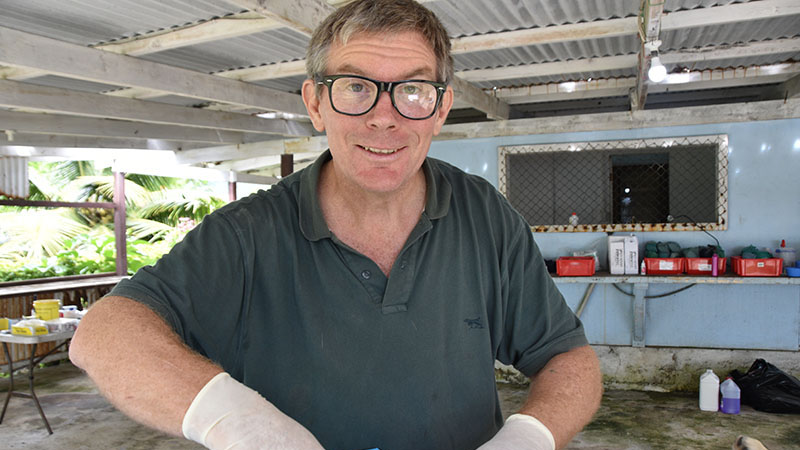PET TALK: Caring for your pet’s teeth
Wednesday 31 August 2022 | Written by CI News Staff | Published in

Te Are Manu Veterinary Clinic services vet Dr Michael Baer. PHOTO: AL WILLIAMS 21092206
It was a proud moment, not to mention a profitable one, when I lost my first tooth. Most people lose their first tooth at 5 or 6 – I was 8.
Because my mouth was so much bigger than my teeth, my father had given me a nickname, “Cage”. Maybe not the kindest nickname, but a pretty good description of my smile. Oh well, the Tooth Fairy helped soothe my injured pride.
Most animals have the same development, a set of baby or milk teeth, which fall out and are replaced by adult teeth. Some animals, like elephants, go through multiple sets. And sharks just have a production line, replacing set after set.
Because losing teeth by a certain age is usually quite reliable (unless you happen to be me), the changes can be used to indicate the age of an animal. Horses, because their teeth grow continuously, can be aged with some accuracy throughout their lives.
This fact has given us the wise old saying “never look a gift horse in the mouth”. If it was free, you wouldn’t want to know just how long in the tooth it was!
Dogs and cats have two sets of teeth. The baby teeth are usually gone and the adult teeth in place by 6 months old. After that there is not much point in trying to age dogs and cats with their teeth. Diet, dental care, and breed affect the mouth more.
The 42 teeth in a healthy dog’s mouth get damaged, infected, broken and fall out when chewing on sticks, stones, bones, and coconuts. Brushing your dog or cats’ teeth can have a big effect on keeping them healthy.
Cattle and goats have a weird setup. They don’t have any top front teeth, instead they have teeth on the bottom and a dental pad on the top. The dental pad is what they bite against to collect grass. And unlike dogs and cats, which have large fangs, or canine teeth, cows and goats have nothing. They have a gap.
The fangs in pigs are what we call their tusks. The same for a walrus. But an elephant’s tusks are its front teeth, or incisors.
The reason for the variation in teeth is the diet of the animal. Teeth can be roughly divided by the purpose they serve; biting, holding, grinding, cutting.
Meat eaters like dogs and cats need biting, holding, and cutting teeth. Grass eaters like goats can do with biting and grinding teeth. Animals with a mixed meat and vegetable diet, like pigs, and people, have a combination of all types.
Elephants use their tusks to tear up trees, strip off bark and for protection. Walruses use their tusks to fight, to dig holes in the ice, and to drag themselves out of the water. Not bad, especially because walruses have almost no use for any of their other teeth.
Teeth are layered; the external layer, enamel, is the hardest structure in the body. It is wrapped around dentine, which is hard but less brittle. And on the inside is the pulp, where all the blood vessels and nerves are.
The root of the tooth, below the gum, is often longer than the crown, and acts as a cantilever. Otherwise, my teeth could pop out when I took a bite. And then I might end up being called “Cage” again.
Taking care of your pet’s teeth is a great step towards keeping her healthy. Dental infections and dental pain are not fun, so a quick flip of the lip to check on dental health always gives valuable information.
Don’t forget if you are in Nikao or Panama to bring your dogs along to the Panama Hall for our desexing clinic.
Most animals have the same development, a set of baby or milk teeth, which fall out and are replaced by adult teeth. Some animals, like elephants, go through multiple sets. And sharks just have a production line, replacing set after set.




































